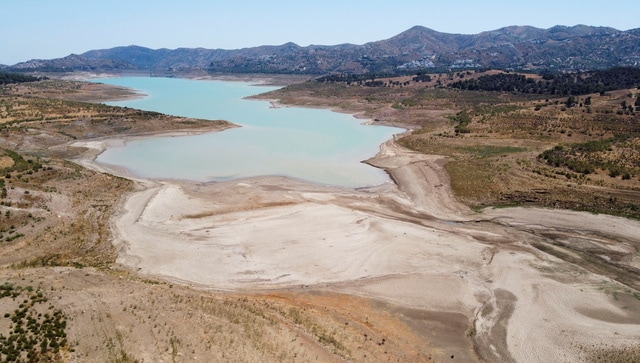Heatwaves are occurring more frequently, becoming more extreme, and beginning sooner than in the past. A brutal heatwave has been sweeping Spain for days, with temperatures 10 to 15 degrees Celsius higher than normal for April. According to the nation’s meteorological service AEMET, the European country experienced its warmest April temperature ever on Thursday, reaching 38.7 degrees Celsius. The intensity of the recent heat wave that affected southern Spain has surprised experts. It has also led the schools to change their timings and public swimming pools to open a month earlier. Spain braces for unusually high temperatures At least three locations in Seville and Huelva recorded temperatures of 37 degrees Celsius on Wednesday. Schools were forced to modify their timings in order to avoid the worst of the heat due to the unusually high spring temperatures , reported The Guardian. In order to avoid lengthy platform delays, the Madrid metro has trains running more often than usual. Additionally, public swimming pools are anticipated to open one month earlier than usual. Cayetano Torres, a spokesperson for Spain’s meteorological office, told BBC, “This is not normal. Temperatures are completely out of control this year." While Maximiliano Herrera, a climatologist who runs an Extreme Temperatures Twitter account said, “This heat event in Spain is absolutely extreme, unprecedented with temperatures never seen before in April. In some locations, records are being beaten by a five degrees Celsius margin, which is something that has happened only a handful of times at weather stations around the world.”
A mass of hot, dry air delivered temperatures between 10 degrees Celsius and 15 degrees Celsius above the seasonal average and more equivalent to high summer in May last year, causing temperatures in some areas of Spain to approach 40 degrees Celsius, reported The Guardian. Then, in June and July, there were two heatwaves that were accompanied by forest fires that destroyed hundreds of thousands of hectares of land throughout Spain. On track for hottest-ever April According to the report, April temperature records have already been broken, with 35.1 degrees Celsius at Córdoba airport earlier this week shattering the previous high of 34 degrees Celsius for the month, and 35 degrees Celsius at Jerez airport shattering the previous record of 33.6 degrees Celsius from 1997. Rubén del Campo, a spokesperson for AEMET predicted that April 2023 would likely break all previous records for warmth. “Confirmation is still pending, but this high-temperature episode will probably be the hottest April in the Iberian peninsula since records began – since at least 1950,” The Guardian quoted him as saying. [caption id=“attachment_12520372” align=“alignnone” width=“640”] Founder of “Weaving the Streets” project, Marina Fernandez Ramos and her father Manuel, put on display one of the canopies made of recycled material to protect people from the intense summer heat in the province of Caceres, Spain, Reuters[/caption] Africa’s hot weather causes Europe to get warmer A slow-moving weather system and a mass of extremely hot air from Africa have propelled the extreme heat in Spain. The Iberian peninsula’s high-pressure system and bright sky are allowing extra sunlight to reach the already parched Spain, which can’t dissipate the heat. In addition, a severe drought that has plagued sections of southern Spain and the country’s northeast, close to Barcelona, coincides with the high temperatures. The Ministry of Ecological Transition in Spain indicated that rainfall levels in March were only 36 per cent of the monthly normal. Reuters reported that the country has experienced 36 consecutive months of below-average rainfall, with reservoirs at only about half of their capacity. In Catalonia, northeastern Spain, reservoir water levels are at about 25 per cent and there are already some water restrictions in place, it said. The country’s agriculture is suffering severely from the water shortage. [caption id=“attachment_12520412” align=“alignnone” width=“640”]
Founder of “Weaving the Streets” project, Marina Fernandez Ramos and her father Manuel, put on display one of the canopies made of recycled material to protect people from the intense summer heat in the province of Caceres, Spain, Reuters[/caption] Africa’s hot weather causes Europe to get warmer A slow-moving weather system and a mass of extremely hot air from Africa have propelled the extreme heat in Spain. The Iberian peninsula’s high-pressure system and bright sky are allowing extra sunlight to reach the already parched Spain, which can’t dissipate the heat. In addition, a severe drought that has plagued sections of southern Spain and the country’s northeast, close to Barcelona, coincides with the high temperatures. The Ministry of Ecological Transition in Spain indicated that rainfall levels in March were only 36 per cent of the monthly normal. Reuters reported that the country has experienced 36 consecutive months of below-average rainfall, with reservoirs at only about half of their capacity. In Catalonia, northeastern Spain, reservoir water levels are at about 25 per cent and there are already some water restrictions in place, it said. The country’s agriculture is suffering severely from the water shortage. [caption id=“attachment_12520412” align=“alignnone” width=“640”] A general view shows La Vinuela reservoir during a severe drought in La Vinuela, near Malaga, southern Spain. A prolonged dry spell and extreme heat made last July the hottest month in Spain since at least 1961. Reuters[/caption] The national weather office has issued a warning that a wide portion of the nation could be at risk due to this combination, which is heightening the possibility of early forest fires. Notably, in 2022, Spain experienced the most land fires of any nation in
Europe
. Experts in the field agree that
climate change
is most definitely a factor in this heatwave. “We know that 2022 was the second warmest year on record for Europe, and it was the warmest summer on record. Europe is warming at twice the global rate and we know because there is a higher rate of warming, there’s a higher probability of extreme events. And those extreme events include heat waves,” BBC quoted Dr Samantha Burgess from the Copernicus climate change service as saying. Del Campo also told The Guardian, “When it comes to the relationship between this kind of weather and climate change, we know that extremely high temperatures have become more frequent and more intense, and this intense and extreme heat is arriving earlier. Although each episode needs to be analysed individually and in detail, this episode fits with what’s happening because of climate change.” Also read: ‘A year of extremes’: What World Meteorological Organization’s 2022 report says about the state of global climate
Heatwaves globally This heatwave in Spain is not an exceptional incident; temperatures in the first few months of this year have broken records all around the world. On 15 April, the temperature in the Southeast Asian country Laos rose to 42.7 degrees Celsius while it reached 45.4 degrees Celsius in northwest Thailand, as per BBC. The temperature in Bangladesh’s capital, Dhaka, rose above 40 degrees Celsius on what was reportedly the warmest day in 58 years.
A general view shows La Vinuela reservoir during a severe drought in La Vinuela, near Malaga, southern Spain. A prolonged dry spell and extreme heat made last July the hottest month in Spain since at least 1961. Reuters[/caption] The national weather office has issued a warning that a wide portion of the nation could be at risk due to this combination, which is heightening the possibility of early forest fires. Notably, in 2022, Spain experienced the most land fires of any nation in
Europe
. Experts in the field agree that
climate change
is most definitely a factor in this heatwave. “We know that 2022 was the second warmest year on record for Europe, and it was the warmest summer on record. Europe is warming at twice the global rate and we know because there is a higher rate of warming, there’s a higher probability of extreme events. And those extreme events include heat waves,” BBC quoted Dr Samantha Burgess from the Copernicus climate change service as saying. Del Campo also told The Guardian, “When it comes to the relationship between this kind of weather and climate change, we know that extremely high temperatures have become more frequent and more intense, and this intense and extreme heat is arriving earlier. Although each episode needs to be analysed individually and in detail, this episode fits with what’s happening because of climate change.” Also read: ‘A year of extremes’: What World Meteorological Organization’s 2022 report says about the state of global climate
Heatwaves globally This heatwave in Spain is not an exceptional incident; temperatures in the first few months of this year have broken records all around the world. On 15 April, the temperature in the Southeast Asian country Laos rose to 42.7 degrees Celsius while it reached 45.4 degrees Celsius in northwest Thailand, as per BBC. The temperature in Bangladesh’s capital, Dhaka, rose above 40 degrees Celsius on what was reportedly the warmest day in 58 years.
The likelihood of an El Nio event also has the potential to affect weather globally during the upcoming months. As a result, the Pacific Ocean off the coast of Peru will become hotter. If it does, 2024 may end up being the warmest year on record, with an increase in storms, fires, and floods. “It seems we are living in a world of a new normal here. These people in regions like Asia are the people who have been adapting to these kinds of extreme temperatures for thousands of years, but it is now getting beyond their ability to adapt. That’s why we are witnessing rising death rates due to heat each year in this part of the world.,” said Dr Fahad Saeed, from research organisation, Climate Analytics told BBC. A recent EU report concluded that the climate crisis had “frightening” impacts in Europe last year, with heatwaves killing more than 20,000 people and drought-withering crops. With inputs from agencies Read all the Latest News , Trending News , Cricket News , Bollywood News , India News and Entertainment News here. Follow us on Facebook , Twitter and Instagram .
)